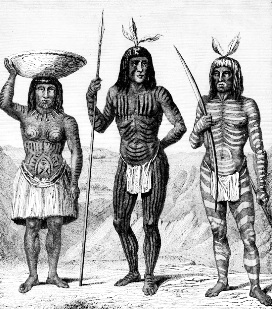The above image is a landscape done by German-born artist Albert Bierstadts, and to me, it reflects the two-sided nature of the colonisation of the American West. The strong light source seemingly coming down from the heavens suggests that the colonisation has an almost biblical significance to it, as if to say that God himself were behind the Americans who dared to journey out west. This symbolism can be linked to John Gast's 'American Progress' painting of 1867, with Lady Liberty appearing almost like an angel, sent to guide the shepherds of God (aka the American settlers) to new and greener pastures. The landscape itself also seems to invoke senses of being similar to the idea of the Garden of Eden, with plenty of trees, animals, green space and a large lake, which could be a perfect place for colonists to start a new life, free from the ties to the Old World. The light, seeing as it likely the Sun, is coming from the east too, symbolising the coming of the colonists from the original Thirteen States. Furthermore, the lake is being filled by a stream of water coming from the same direction that the light is coming from; one could infer from this that the lake is the American West, and the stream of water is representative of the colonists, slowly but surely trickling in and filling up the American West.
However, there is some negative imagery here as well, intentional or otherwise. There is a section of darkness heading towards the valley at the same pace at the light, suggesting that the colonists are an oncoming storm that will bring ruination to the valley, and the American West as a whole. This could be another biblical reference, for mankind, in the form of Adam and Eve, was banished from the Garden of Eden after tampering it by eating from the Forbidden Tree. Also, some of the trees appear bent back, and the entrance to the valley itself looks broken into, almost as if to say the colonists are forcing themselves upon the West, implying further that nothing good will come from the American colonisation of the West.
The Mojave Indians:

The Mojave Indians are a tribe of American Indians who settled primarily in the Mojave Desert, in the states of California and Nevada. The Mojave Indians were also known as the Pipa Aha Macav, or 'The People by the River', and over time, they grew to be experienced farmers, with trading networks and well-established towns going out almost as far as the Pacific Ocean. In the Mojave culture, the origins of the tribe can be traced back to the highest peak of the Newberry Mountains in what is now the Lake Mead National Recreation Area; this peak is known as the Spirit Mountain, and may have something to do with the origins of the tribe proper. It is said that the Mojave's spirit mentor, Mutavilya, created the Colorado River and its accompanying ecosystem of plants and animals, and subsequently taught the Mojave how to farm, prosper and look after the land, essentially teaching them the art of civilisation.
The website has a significant amount of history of the Mojave tribe, and even describes how the Mojave hold an annual celebration which allows members of tribes across the United States to celebrate their rich heritage, which shows that the Mojave are not afraid to show off their history, which in turn is part of the diverse history of an entire race. However, as with some other American Indian websites, it eventually, and in this case rapidly, devolved into promoting casinos, thus fulfilling the stereotype that surviving Indians in this day and age tend to run casinos and have gambling problems. This is a shame, as the Mojave seem to have a rich history, just like many other tribes of American Indians, but it cannot be helped, as the events that made the Indians what they are today have already come to pass.
http://www.renegadetribune.com/albert-bierstadts-lavish-landscapes-american-west/
http://mojaveindiantribe.com/about/
No comments:
Post a Comment